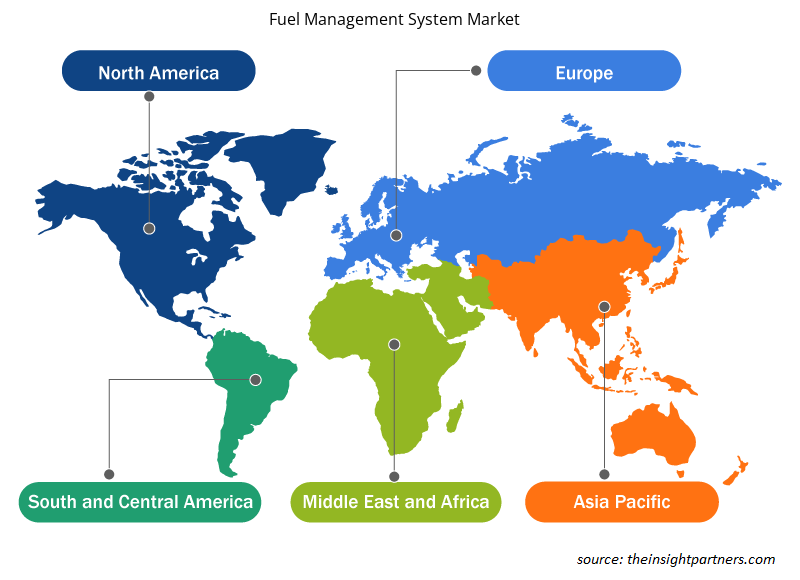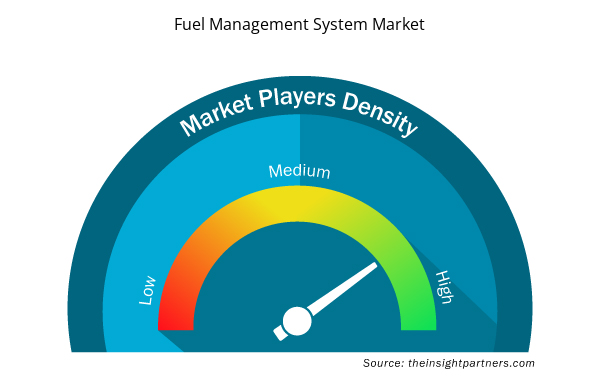燃料管理システムの市場規模は、2023年の12億1,000万米ドルから2031年には25億2,000万米ドルに達すると予測されています。市場は2023年から2031年の間に9.8%のCAGRを記録すると予想されています。燃料消費の監視と制御の需要の増加と燃料盗難の増加は、市場の主要なトレンドであり続けると思われます。
燃料管理システム市場分析
燃料管理システム市場の需要は、複数の業界で生産性と効率性を向上させるためのより優れた燃料管理の必要性が高まるにつれて、拡大すると予想されます。さらに、より良い顧客体験を提供するための電子商取引プラットフォームの急速な成長により、供給および物流業界はIoT産業を強化するようになりました。
燃料管理システム市場の概要
燃料管理システムは、輸送、建設、エネルギー業界などのさまざまなアプリケーションで燃料消費を監視、制御、最適化するために使用されるソフトウェアおよびハードウェア テクノロジの一種です。車両では、燃料管理システムは、燃料消費、エンジン パフォーマンス、およびその他の要因を監視することで、燃料が効率的に使用されていることを確認するのに役立ちます。これにより、燃料コストを削減し、運用効率を高め、排出量を削減できます。
要件に合わせてレポートをカスタマイズする
このレポートの一部、国レベルの分析、Excelデータパックなど、あらゆるレポートを無料でカスタマイズできます。また、スタートアップや大学向けのお得なオファーや割引もご利用いただけます。
- このレポートの主要な市場動向を入手してください。この無料サンプルには、市場動向から見積もりや予測に至るまでのデータ分析が含まれます。
燃料管理システム市場の推進要因と機会
燃料消費の監視と制御の需要増加が市場を有利にする
燃料消費の監視と制御に対する需要の高まりが、燃料管理システム市場を牽引しています。これは、燃料消費を監視することにはいくつかの利点があるためです。コスト削減、非効率性の特定、排出量の削減などの利点があります。さらに、リアルタイムの燃料消費監視に対する需要も高まっています。これにより、企業は事後ではなく、発生した時点で燃料の無駄を特定して対処できます。これにより、企業は燃料消費とコストをリアルタイムで削減することができ、収益に大きな影響を与えることができます。燃料消費の監視と制御にはいくつかの利点があるため、燃料管理システムは需要があります。
燃料管理システムにおける技術的進歩。
燃料管理システムの技術的進歩には、さまざまなチャンスがあります。IoT統合、予測分析、機械学習アルゴリズム、透明性のためのブロックチェーン、エネルギー効率の高い車両などの技術的進歩は、物流と輸送、製造とサプライ チェーン、農業、建設、車両管理とサービスなど、さまざまな業界に役立ちます。したがって、さまざまな業界での技術的進歩により、燃料管理システムの需要が高まります。
燃料管理システム市場レポートのセグメンテーション分析
燃料管理システム市場分析の導出に貢献した主要なセグメントは、コンポーネント、機能、およびエンドユーザーです。
- コンポーネントに基づいて、燃料管理システム市場はハードウェアとソフトウェアに分かれています。ソフトウェアセグメントは、予測期間中に大きな市場シェアを占めると予想されます。
- 機能に基づいて、燃料管理システム市場は配送と保管に分けられます。配送セグメントは予測期間中に大きな市場シェアを占めると予想されます。
- エンドユーザー別に見ると、市場は鉱業、建設・港湾、輸送・物流、石油・ガス、その他に分類されています。鉱業セグメントは予測期間中に大きな市場シェアを占めると予想されます。
地域別燃料管理システム市場シェア分析
燃料管理システム市場レポートの地理的範囲は、主に北米、アジア太平洋、ヨーロッパ、中東およびアフリカ、南米および中米の 5 つの地域に分かれています。
北米は燃料管理システム市場を支配してきました。北米地域のさまざまな業界でのハイテク採用の傾向が、燃料管理システム市場の成長を後押ししています。デジタルツールの採用の増加や政府機関による多額の技術支出などの要因が、北米の燃料管理システム市場の成長を牽引すると予想されています。さらに、米国とカナダの先進国では研究開発に重点が置かれているため、北米のプレーヤーは技術的に高度なソリューションを市場に投入せざるを得ません。さらに、米国には多くの燃料管理システム市場プレーヤーがおり、革新的なソリューションの開発にますます重点を置いています。これらすべての要因が、この地域の燃料管理システム市場の成長に貢献しています。
燃料管理システム市場の地域別分析
予測期間を通じて燃料管理システム市場に影響を与える地域的な傾向と要因は、Insight Partners のアナリストによって徹底的に説明されています。このセクションでは、北米、ヨーロッパ、アジア太平洋、中東およびアフリカ、南米および中米にわたる燃料管理システム市場のセグメントと地理についても説明します。

- 燃料管理システム市場の地域別データを入手
燃料管理システム市場レポートの範囲
| レポート属性 | 詳細 |
|---|---|
| 2023年の市場規模 | 12億1千万米ドル |
| 2031年までの市場規模 | 25億2千万米ドル |
| 世界のCAGR(2023年~2031年) | 9.6% |
| 履歴データ | 2021-2022 |
| 予測期間 | 2024-2031 |
| 対象セグメント | コンポーネント別
|
| 対象地域と国 | 北米
|
| 市場リーダーと主要企業プロフィール |
|
市場プレーヤーの密度:ビジネスダイナミクスへの影響を理解する
燃料管理システム市場は、消費者の嗜好の変化、技術の進歩、製品の利点に対する認識の高まりなどの要因により、エンドユーザーの需要が高まり、急速に成長しています。需要が高まるにつれて、企業は提供を拡大し、消費者のニーズを満たすために革新し、新たなトレンドを活用し、市場の成長をさらに促進しています。
市場プレーヤー密度とは、特定の市場または業界内で活動している企業または会社の分布を指します。これは、特定の市場スペースに、その規模または総市場価値と比較して、どれだけの競合相手 (市場プレーヤー) が存在するかを示します。
燃料管理システム市場で事業を展開している主要企業は次のとおりです。
- シェビン フリート ソリューション
- フランクリンエレクトリック
- ギルバルコ株式会社
- マルチフォースシステムズ株式会社。
- ナビ8
- ピウジ SpA
免責事項:上記の企業は、特定の順序でランク付けされていません。

- 燃料管理システム市場のトップキープレーヤーの概要を入手
燃料管理システム市場のニュースと最近の動向
燃料管理システム市場は、主要な企業出版物、協会データ、データベースなどの一次調査と二次調査後の定性的および定量的データを収集することによって評価されます。燃料管理システム市場におけるいくつかの開発を以下に示します。
- Kongsberg Digital と Royston は提携して電子燃料管理システムを提供しています。この提携により、船主は Kongsberg Digital の Vessel Insight と Royston の電子燃料管理システムである Enginei を組み合わせることで、燃料消費を最適化し、透明性を高め、船舶運航の脱炭素化を促進できるようになります。(出典: Royston、プレス カンパニー ウェブサイト、2024 年 2 月)
- エアバスは、持続可能な航空燃料(SAF)の新興リーダーであるDG Fuels, LLC(「DGF」)と戦略的パートナーになりました。DGFの燃料生産システムは、伐採産業からの木材廃棄物などのセルロース廃棄物と、風力や太陽光発電などの再生可能エネルギー源のみに基づいています。(出典:エアバス社ウェブサイト、2023年9月)
燃料管理システム市場レポートの対象範囲と成果物
「燃料管理システム市場規模と予測(2021〜2031年)」レポートでは、以下の分野をカバーする市場の詳細な分析を提供しています。
- 対象範囲に含まれるすべての主要市場セグメントについて、世界、地域、国レベルでの燃料管理システム市場規模と予測。
- 燃料管理システム市場の動向、および推進要因、制約、主要な機会などの市場動向。
- 詳細なPEST/ポーターの5つの力とSWOT分析
- 主要な市場動向、世界および地域の枠組み、主要プレーヤー、規制、最近の市場動向を網羅した燃料管理システム市場分析。
- 市場集中、ヒートマップ分析、主要プレーヤー、燃料管理システム市場の最近の動向を網羅した業界の状況と競争分析。
- 詳細な企業プロフィール。
- 過去2年間の分析、基準年、CAGRによる予測(7年間)
- PEST分析とSWOT分析
- 市場規模価値/数量 - 世界、地域、国
- 業界と競争環境
- Excel データセット



Report Coverage
Revenue forecast, Company Analysis, Industry landscape, Growth factors, and Trends

Segment Covered
This text is related
to segments covered.

Regional Scope
North America, Europe, Asia Pacific, Middle East & Africa, South & Central America

Country Scope
This text is related
to country scope.
よくある質問
The expected CAGR of the fuel management system market is 9.6%.
The global fuel management system market is expected to reach US$ 2.52 billion by 2031.
The use of real-time monitoring is anticipated to drive the market in the forecast period.
The key players holding majority shares in the global fuel management system market are Chevin Fleet Solutions, Franklin Electric, Gilbarco Inc., Multiforce Systems Corporation., Navig8, Piusi S.p.A., OPW Fuel Management Systems Corporate, Orpak Systems Ltd., Banlaw, Syntech Systems, Inc., etc.
Increasing demand for monitoring and controlling fuel consumption and increasing cases of fuel theft are some of the factors driving the fuel management system market.
North America is anticipated to dominate the fuel management system market in 2023.
Trends and growth analysis reports related to Technology, Media and Telecommunications : READ MORE..
The Insight Partners performs research in 4 major stages: Data Collection & Secondary Research, Primary Research, Data Analysis and Data Triangulation & Final Review.
- Data Collection and Secondary Research:
As a market research and consulting firm operating from a decade, we have published and advised several client across the globe. First step for any study will start with an assessment of currently available data and insights from existing reports. Further, historical and current market information is collected from Investor Presentations, Annual Reports, SEC Filings, etc., and other information related to company’s performance and market positioning are gathered from Paid Databases (Factiva, Hoovers, and Reuters) and various other publications available in public domain.
Several associations trade associates, technical forums, institutes, societies and organization are accessed to gain technical as well as market related insights through their publications such as research papers, blogs and press releases related to the studies are referred to get cues about the market. Further, white papers, journals, magazines, and other news articles published in last 3 years are scrutinized and analyzed to understand the current market trends.
- Primary Research:
The primarily interview analysis comprise of data obtained from industry participants interview and answers to survey questions gathered by in-house primary team.
For primary research, interviews are conducted with industry experts/CEOs/Marketing Managers/VPs/Subject Matter Experts from both demand and supply side to get a 360-degree view of the market. The primary team conducts several interviews based on the complexity of the markets to understand the various market trends and dynamics which makes research more credible and precise.
A typical research interview fulfils the following functions:
- Provides first-hand information on the market size, market trends, growth trends, competitive landscape, and outlook
- Validates and strengthens in-house secondary research findings
- Develops the analysis team’s expertise and market understanding
Primary research involves email interactions and telephone interviews for each market, category, segment, and sub-segment across geographies. The participants who typically take part in such a process include, but are not limited to:
- Industry participants: VPs, business development managers, market intelligence managers and national sales managers
- Outside experts: Valuation experts, research analysts and key opinion leaders specializing in the electronics and semiconductor industry.
Below is the breakup of our primary respondents by company, designation, and region:

Once we receive the confirmation from primary research sources or primary respondents, we finalize the base year market estimation and forecast the data as per the macroeconomic and microeconomic factors assessed during data collection.
- Data Analysis:
Once data is validated through both secondary as well as primary respondents, we finalize the market estimations by hypothesis formulation and factor analysis at regional and country level.
- Macro-Economic Factor Analysis:
We analyse macroeconomic indicators such the gross domestic product (GDP), increase in the demand for goods and services across industries, technological advancement, regional economic growth, governmental policies, the influence of COVID-19, PEST analysis, and other aspects. This analysis aids in setting benchmarks for various nations/regions and approximating market splits. Additionally, the general trend of the aforementioned components aid in determining the market's development possibilities.
- Country Level Data:
Various factors that are especially aligned to the country are taken into account to determine the market size for a certain area and country, including the presence of vendors, such as headquarters and offices, the country's GDP, demand patterns, and industry growth. To comprehend the market dynamics for the nation, a number of growth variables, inhibitors, application areas, and current market trends are researched. The aforementioned elements aid in determining the country's overall market's growth potential.
- Company Profile:
The “Table of Contents” is formulated by listing and analyzing more than 25 - 30 companies operating in the market ecosystem across geographies. However, we profile only 10 companies as a standard practice in our syndicate reports. These 10 companies comprise leading, emerging, and regional players. Nonetheless, our analysis is not restricted to the 10 listed companies, we also analyze other companies present in the market to develop a holistic view and understand the prevailing trends. The “Company Profiles” section in the report covers key facts, business description, products & services, financial information, SWOT analysis, and key developments. The financial information presented is extracted from the annual reports and official documents of the publicly listed companies. Upon collecting the information for the sections of respective companies, we verify them via various primary sources and then compile the data in respective company profiles. The company level information helps us in deriving the base number as well as in forecasting the market size.
- Developing Base Number:
Aggregation of sales statistics (2020-2022) and macro-economic factor, and other secondary and primary research insights are utilized to arrive at base number and related market shares for 2022. The data gaps are identified in this step and relevant market data is analyzed, collected from paid primary interviews or databases. On finalizing the base year market size, forecasts are developed on the basis of macro-economic, industry and market growth factors and company level analysis.
- Data Triangulation and Final Review:
The market findings and base year market size calculations are validated from supply as well as demand side. Demand side validations are based on macro-economic factor analysis and benchmarks for respective regions and countries. In case of supply side validations, revenues of major companies are estimated (in case not available) based on industry benchmark, approximate number of employees, product portfolio, and primary interviews revenues are gathered. Further revenue from target product/service segment is assessed to avoid overshooting of market statistics. In case of heavy deviations between supply and demand side values, all thes steps are repeated to achieve synchronization.
We follow an iterative model, wherein we share our research findings with Subject Matter Experts (SME’s) and Key Opinion Leaders (KOLs) until consensus view of the market is not formulated – this model negates any drastic deviation in the opinions of experts. Only validated and universally acceptable research findings are quoted in our reports.
We have important check points that we use to validate our research findings – which we call – data triangulation, where we validate the information, we generate from secondary sources with primary interviews and then we re-validate with our internal data bases and Subject matter experts. This comprehensive model enables us to deliver high quality, reliable data in shortest possible time.


 このレポートの無料サンプルを入手する
このレポートの無料サンプルを入手する